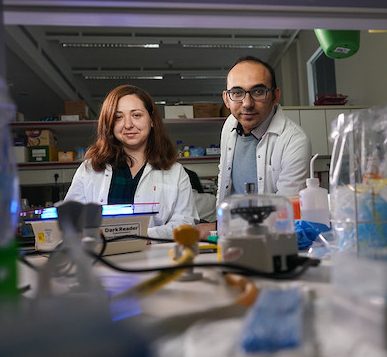From Bacteria to Biological Computer
Technion Researchers Turn Bacterial Cell Into Biological Computer
Researchers at the Technion have created a biological computer, constructed within a bacterial cell and capable of monitoring different substances in the environment. Currently, the computer identifies and reports on toxic and other materials. Next up: the ability to warn about hemorrhaging in the human body.

Ph.D. student Natalie Barger and Assistant Professor Ramez Daniel
The research by Ph.D. student Natalia Barger and Assistant Professor Ramez Daniel, head of the Synthetic Biology and Bioelectronics Lab at the Technion’s Faculty of Biomedical Engineering, was published in September 2019 in the journal Nucleic Acids Research (NAR).
In recent decades, the barriers between engineering and life sciences have been falling, and from the encounter between the two different disciplines, a new science – synthetic biology – was born. Synthetic biology introduces engineering into biology, makes it possible to design and build biological systems that don’t exist in nature, and supplies an innovative toolbox for reprogramming the genetic code in living creatures, including humans.
In their NAR article, the researchers present a reorganization of the complex genetic structure of bacterial luciferase – proteins involved in the creation of light by bacterial cell.
“We built a kind of biological computer in the living cells. In this computer, as in regular computers, circuits carry out complicated calculations,” said Barger. “Only here, these circuits are genetic, not electronic, and information are carried by proteins and not electrons.”
Bacterial luciferase and its substrate are encoded by five genes, and is responsible for generating light in the bacterial cell. By splitting the natural structure of the luciferase, the researchers created various genetic circuits and inserted them into the cells of E. coli bacteria. The result was that the engineered bacteria transmit signals as a product of computational action within the cell. In this way, they can serve as smart biosensors, analytical tools for monitoring and quantifying environmental infections and other toxic substances.
“Today, similar devices in bacteria already exist, but these are based on the existing system (luciferase) as it is,” explained the researchers. “On the other hand, we have reconfigured the system to work the way we want so as to locate the materials and the combinations of materials that interest the user. Even more so, our system is able to cope with multiple inputs – that is, with different materials simultaneously. The problem we face – the accurate identification of input – is difficult to solve at the measurement story or after that, and the optimal solution lies at the intracellular level.”
The first application of the innovative system has been tested and successfully functioned by monitoring Nalidixic acid and hydrogen peroxide – toxic substances that harm the DNA and drive cancer processes. At the next stage, the researchers will examine the possibility of programming the bacterial cell to warn of bleeding in the human body.
“Our research takes synthetic biology one step further and makes biology an accurate and planned science,” concluded Prof. Daniel. “The world in general, and the Technion in particular, are now working to tighten the interface between life sciences and engineering. In the current study, we developed a complex biocomputer, that is, a programmed biological system that fulfills complex tasks. In essence, we are introducing here a new, or renewed, organism that was not created in a normal evolutionary process but in a planned engineering process.”
Assistant Prof. Ramez Daniel completed his bachelor’s degree in the Technion’s Viterbi Faculty of Electrical Engineering and his M.Sc. and Ph.D. in electronics and electrical engineering at Tel Aviv University. He worked for eight years as a circuit designer in TowerJazz (the global specialty foundry leader that specializes in manufacturing analog integrated electronic circuits). After his PhD, he conducted his postdoctoral fellowship at the Massachusetts Institute of Technology, where he built the first biological computer inside a bacterium. Since 2014, he has headed the Synthetic Biology and Bioelectronics Lab in the Technion’s Faculty of Biomedical Engineering.
Natalia Barger completed her bachelor’s and master’s degrees in the Technion’s Faculty of Civil and Environmental Engineering. This year, she is expected to complete her doctorate in biomedical engineering.


